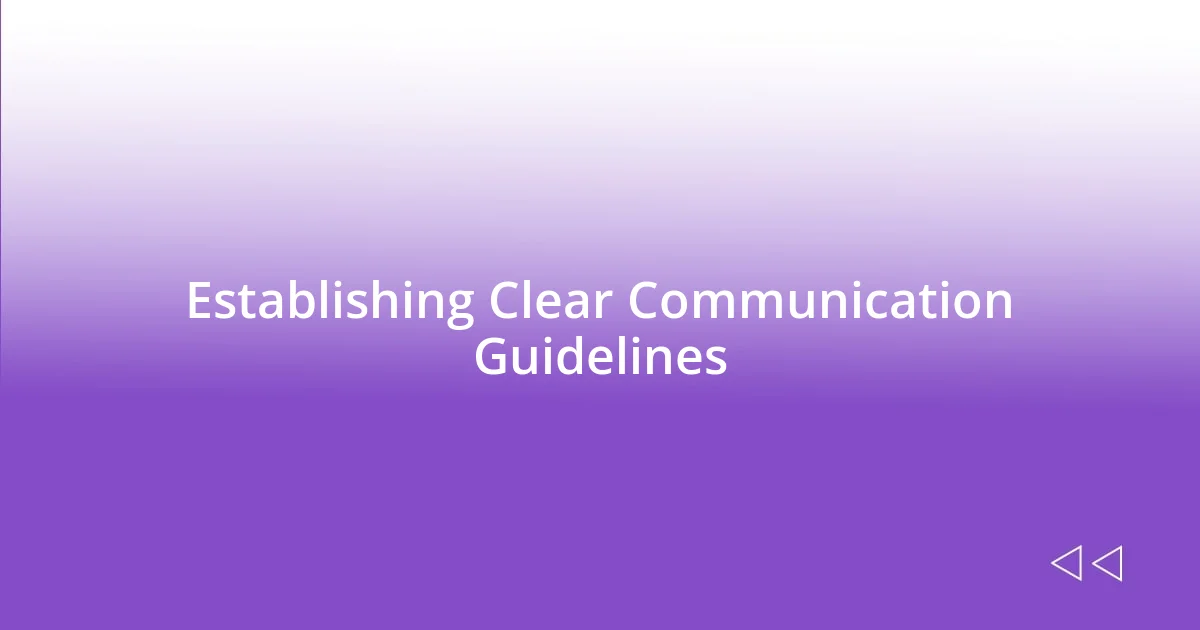Key takeaways:
- Creativity thrives in a supportive environment where diverse perspectives are embraced, allowing for innovative solutions and increased engagement.
- Establishing clear communication guidelines fosters collaboration, while balancing structure with creative freedom can enhance the creative process.
- Regular evaluation and open feedback channels help sustain creativity in partnerships, and celebrating small wins keeps team motivation high.

Understanding Creativity in Collaborations
Creativity in collaborations is an intriguing dance of ideas, personalities, and perspectives. I remember working on a group project once where everyone thought they had to be the loudest voice to share their ideas. It struck me how often we forget that creativity thrives in a supportive environment. When everyone feels free to express their thoughts without the fear of criticism, something magical happens—ideas flourish.
Have you ever noticed how some teams spark creativity effortlessly? This often originates from a foundational understanding of each member’s strengths and weaknesses. In my experience, great collaborations often come from recognizing that every person brings something unique to the table. I recall a time when a quieter team member proposed a radical idea that shifted our entire direction; it was a reminder that creativity doesn’t always shout—sometimes, it whispers.
Another vital aspect to understand about creativity in collaborations is the balance between individual contributions and collective synergy. It’s fascinating how a single idea can morph into something greater through the input of various minds. I find myself asking: how can we cultivate an atmosphere where individuals feel empowered and valued? This balance, if achieved, not only enhances creativity but also strengthens the bonds within the team.

Importance of Diverse Perspectives
Diverse perspectives are foundational to innovation and creative growth in collaborative efforts. When various viewpoints converge, it enriches the dialogue, leading to fresh solutions that may not have emerged in a more homogenous group. I’ve experienced firsthand how a well-rounded team, representing different backgrounds and skills, can generate ideas that are both innovative and practical. Each person’s unique insight contributes to a tapestry of creative thought, creating something greater than the sum of its parts.
Here are some key benefits of embracing diverse perspectives:
- Enhanced Creativity: Different experiences inspire unique solutions, leading to innovative thinking.
- Problem-Solving: A variety of viewpoints helps identify potential challenges and develops effective strategies to overcome them.
- Increased Engagement: Team members feel valued when their voices are heard, boosting motivation and collaboration.
- Broader Market Reach: Diverse teams can tailor their ideas to appeal to a wider audience, enhancing relevance and connection.
In one of my previous projects, our team blended artists, engineers, and marketers. The marketing team’s insights on audience preferences helped shape our creative direction, while the artists pushed boundaries that the engineers had initially deemed impractical. This collaboration taught me that when we actively seek out and embrace these differences, we open doors to creativity that can truly transform our work.

Establishing Clear Communication Guidelines
Establishing clear communication guidelines is crucial for any collaborative effort. In my view, these guidelines act as a shared map, guiding everyone towards a common destination. For instance, during a project involving a tight deadline, we set up daily check-ins to address concerns and celebrate small victories. This simple practice transformed our workflow and made everyone feel included and heard.
I always emphasize the importance of setting expectations upfront. By sharing preferences for communication styles and preferred platforms—be it email, chat apps, or face-to-face meetings—we minimize misinterpretations and keep engagement high. Reflecting on my past experiences, I once worked with a team that used a single messaging platform. This clarity not only streamlined our conversations but also prevented vital information from getting lost in the shuffle.
When developing communication guidelines, I believe it’s essential to be flexible and open. The ability to adapt based on team dynamics can foster creativity. In one particularly memorable project, we initially communicated through emails, but as the team’s energy evolved, we switched to instant messaging. This shift allowed for quicker feedback and spontaneous brainstorming, amplifying our creative output significantly.
| Communication Method | Impact on Collaboration |
|---|---|
| Daily Check-Ins | Enhances team coherence and allows for real-time problem-solving. |
| Dedicated Messaging Platform | Reduces confusion and ensures everyone stays on the same page. |
| Flexible Communication Styles | Encourages team members to express themselves comfortably, promoting creativity. |

Setting Boundaries for Creative Freedom
Finding the right balance between structure and freedom in creativity can be challenging. I often think of setting boundaries for creative freedom as building a safety net—one that protects creativity while allowing it to soar. In one project, I found it helpful to establish specific areas where team members could innovate, while also outlining non-negotiable objectives. This approach not only sparked creativity but also gave everyone the confidence to explore beyond their usual limits.
When I reflect on my experiences, it’s clear that boundaries don’t stifle creativity; they can actually enhance it. I once worked on a design project where we dedicated time for “creative sprints” within set parameters. These time-bound sessions encouraged participants to think wildly while keeping our objectives in sight. I remember one designer who initially felt constrained, but when given specific themes and challenges, their creativity flourished in ways we hadn’t anticipated. Isn’t it fascinating how boundaries can create a framework where innovation thrives?
Setting boundaries might feel counterintuitive at times, but it fosters a sense of security. I recall a team brainstorming session where, by simply agreeing on three core themes to stick to, we ended up with ideas that felt rich and relevant. It’s a bit like giving artists a blank canvas while simultaneously defining a color palette; it opens up avenues for exploration within a framework. Wouldn’t you agree that these limitations can lead to surprising and delightful outcomes?

Techniques for Encouraging Creative Input
In my experience, creating a brainstorming environment where team members feel safe to share their ideas is essential. I remember a session where we implemented a “no bad ideas” rule. This simple yet powerful technique transformed the atmosphere. Suddenly, even the wildest ideas were welcomed, and that sparked a wave of creativity nobody anticipated. Doesn’t it feel refreshing when everyone knows their voice matters?
Incorporating playful elements can really energize a creative collaboration. I once attended a team workshop that started with a game designed to break the ice. We spent the first 30 minutes drawing silly doodles instead of diving straight into our serious agenda. It might sound trivial, but this playful approach instantly made us feel connected and willing to take risks during our discussions. Have you ever noticed how a bit of fun can unlock hidden potential?
I’ve also found value in rotating roles during collaborative sessions. By allowing team members to lead discussions or present ideas, it creates a sense of ownership and investment in the process. For instance, in one project, we designated a “creativity captain” role that rotated each week. This strategy not only empowered everyone but also revealed different perspectives—the last captain uncovered insights that otherwise may have been overlooked. Isn’t it fascinating how stepping into different shoes can reshape our thinking?

Evaluating Collaborative Outcomes
Evaluating the outcomes of a collaborative effort is truly a revealing experience. I once found myself deep into a project that took months to develop, and when we finally assessed our results, it was eye-opening. While we achieved our goals, I realized some creative ideas we had passionately pursued didn’t resonate with our audience as we hoped. Isn’t it intriguing how sometimes what feels right creatively may not translate effectively in reality?
To effectively evaluate collaborative outcomes, I’ve learned the importance of gathering feedback from all team members. In one particular project, after wrapping up our campaign, we held a reflective session where everyone was encouraged to share their thoughts. That’s when I discovered that some quiet team members had insightful observations that could have shifted our direction. It made me wonder—how often do we overlook valuable perspectives simply because they’re not voiced?
Looking at both qualitative and quantitative metrics can also be a game changer. In another experience, we tracked engagement rates and compared them against the emotional reactions we documented during our brainstorming sessions. The data showed a stark contrast between our perceived success and the actual impact. This taught me that numbers and feelings often tell very different stories, leading me to question how I define success in collaboration. Isn’t it essential to be open-minded and embrace both the qualitative and quantitative?

Sustaining Creativity in Ongoing Partnerships
Sustaining creativity in ongoing partnerships can be a challenging yet rewarding endeavor. I recall a project where we faced a creative slump halfway through our timeline. To revitalize our energy, we introduced regular “inspiration sessions,” where each team member brought in something they found intriguing—like a book, a podcast, or even a piece of art. It was amazing to see how these shared moments reignited our spark and led to unexpected avenues of exploration. Have you ever noticed how fresh inspiration can transform your perspective?
It’s also crucial to maintain open channels of communication throughout the partnership. For instance, during one long-term collaboration, we developed a shared digital board where we could continuously post new ideas, thoughts, and even our frustrations. This constant presence of dialogue created a dynamic space of ongoing creativity. Isn’t it fascinating how just sharing daily experiences can build a deeper connection and keep creativity flowing?
Lastly, I believe in celebrating small wins along the way. In a recent partnership, we made it a point to acknowledge not just the major milestones, but also the incremental achievements. I remember the joy we felt when one of our brainstorming sessions led to a viable concept. We broke out into cheers, and it positively charged the atmosphere. Isn’t it incredible how even the smallest victories can motivate a team to stay innovative and engaged?














